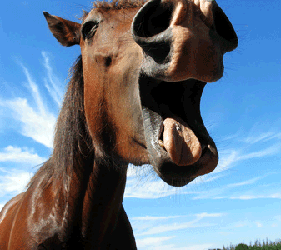Your horse's health is essential! To keep your horse in excellent
condition, it's a great idea to get into a routine to do a daily health check.
Don't worry--a health check takes just a few minutes! However, to make it more
meaningful, it is important that you know signs of a healthy horse, as well as
the signs of a horse that is in bad shape. Go through this checklist to make
sure that your horse is in great health condition!
What expression do you get from your horse? You can often tell if your
horse is not feeling any good just by examining his expression. You get to see
your horse every single day, and you will definitely know what to expect. If
your horse, that is normally curious, alert, and ears-forward, keeps hanging
his head and has dull eyes, he could not be feeling well. Observe him closely
and if there is no improvement, contact your vet.
How is his standing position? Horses that are relaxing often stand with head
down and one hind leg is resting – a perfectly normal posture! However, if the
horse is waiting in his pasture or stall which has a front leg resting, you may
need to have him checked. Trot your horse out to check if there are indications
of lameness. If you aren't sure, call your vet and have him do the test. Generally,
horses do not stand with a resting front leg.
How is his lying position? All horses lie down and often it is to rest,
as well as other times it is just to enjoy the sun. If your horse is rolling
over on the ground under the sun, just leave him alone; he’s just having a good
time. While every horse occasionally enjoys rolling over, constant rolling
coupled with agitation may indicate stomach problems. If your horse rolls
restlessly and seems agitated, he could have colic and this should prompt you
to call the vet.
Check his appetite. When it comes to feeding, most horses love to eat!
In case your horse does not belong to this category, you will know something is
wrong if he leaves his food alone. A horse who isn't feeling well may lose his
appetite, and may also stop drinking water. If loss of appetite persists,
consult your vet.
Check his legs. This can be an everyday thing for you to do. Horses can
injure themselves anywhere. Run your hands down his legs, feeling for wounds, bumps,
heat , and swelling. It might take some time, but at some point you should know
the difference between a normal leg temperature and an elevated temperature.
Inspect the horse's manure. The manure is an excellent sign of horse
health. You most probably know how normal manure looks. The balls are very well
formed but an easy task to break in half. If your balls seem extremely dry or
hard, suspect that your particular horse just isn't drinking enough water.
Loose manure can mean a couple things. Either your horse has too rich of a diet,
or he could be harboring parasites inside. Always check for presence of worms.
Worms within your horse’s manure imply that he is carrying dangerous,
occasionally deadly, internal equine parasites.
If you spot some, call your vet to formulate an appropriate equine worming program.












